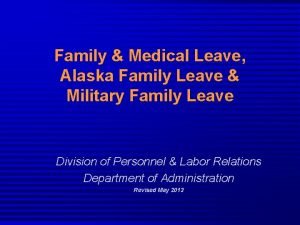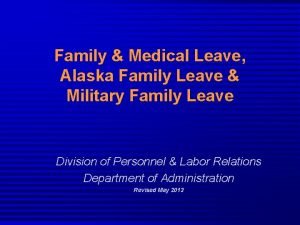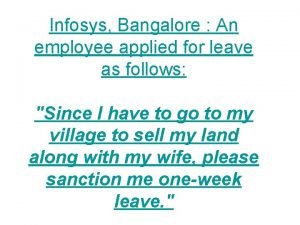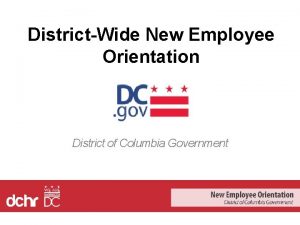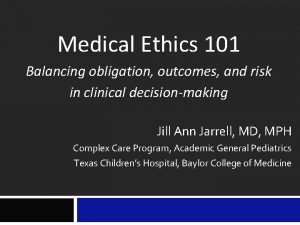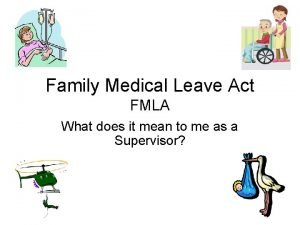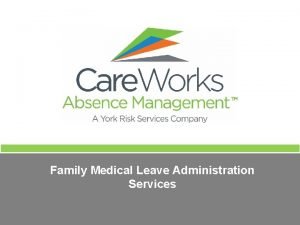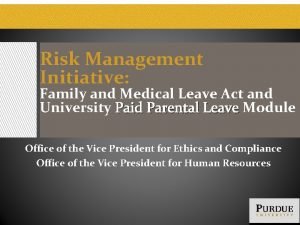HR 101 Family Medical Leave Act WHAT DOES











- Slides: 11

HR 101 Family Medical Leave Act

WHAT DOES FMLA LEAVE DO? FMLA provides up to 12 -weeks of unpaid, job-protected leave for employees within a 12 -month period. WHO CAN USE FMLA LEAVE? Employee Criteria 1. Must have worked for DRTC for at least 12 months 2. Does not have to be consecutive (seasonal work counts); Cannot have a break in service that lasted more than 7 years – if so, the period prior to that 7 -year break does not count towards the 12 month requirement. Must have worked for DRTC for at least 1250 hours in the 12 months before leave is taken • Averages to be about 24 hours per week

WHEN CAN FMLA LEAVE BE USED? Serious Health Condition Employees may take leave for themselves or to care for a spouse, child or parent who has a serious health condition. Serious Health Condition Examples The most common serious health conditions that qualify include: 1. Conditions requiring an overnight stay in a hospital or other medical care facility; 2. Conditions that incapacitate the employee or a family member (making them unable to attend work or school, for example) for more than 3 consecutive days and have ongoing medical treatment. Example: Either multiple appointments with a health care provider or a single appointment and follow-up care such as therapy appointments); 3. Prolonged conditions that cause occasional periods when the employee or a family member are incapacitated and require treatment by a health care provider at least twice per year; and 4. Pregnancy (including prenatal appointments, incapacity due to morning sickness, and medically required bed rest).

EXPANDING FAMILY FMLA leave may be taken for the birth of a child or to bond with the newborn, or for the placement of a child for adoption or foster care and subsequent bonding time. Both men and women have the same right to take FMLA leave to bond with a child, but it must be taken within 1 yr. of the child’s birth or placement and must be taken as a consecutive block of leave unless deemed by the employer otherwise (intermittent leave). If both an employee and their spouse are employed by DRTC, then the employees are entitled to a combined twelve (12) workweeks of family leave for the birth of a child, the placement of a child for adoption or foster care, and the care of parent and/or child that has a serious health condition. HOW CAN FMLA BE USED? FMLA leave may be taken as a single block of time (such as three weeks of leave to recover from surgery) or in multiple, smaller blocks of time. If multiple periods of leave are needed for planned medical treatment (such as physical therapy appointments), they must be scheduled so that they minimize the disruption to the employer. Intermittent Leave - Taken in separate blocks of time for a single illness or injury; flare-ups of chronic conditions such as asthma or diabetes, or for physical therapy.

Reduced-leave schedule – Results in a regular change or reduction of scheduled work hours during the certified period. 2 days Return to Work notice provided to employer upon release by physician. Employees are required to inform DRTC of any changes that have occurred that impact their FMLA leave DRTC also requires that employees provide periodic updates on their status and their intent to return (or not return) from work (continuous FMLA leave) – employees on a continuous FMLA do not call in daily; Employees must follow DRTC’s standard notice or call-in procedures if on Intermittent leave unless they are unable to do so (such as emergency medical care) Health insurance is maintained as if the employee was not on leave (normal employee contributions will be required).

HOW IS FMLA LEAVE REQUESTED? Employees should provide their employer with appropriate notice of leave. If known in advance, employees should provide up to 30 days advance notice. If that is not possible, employees should give notice as soon as possible (generally either the day they learn of the need for leave or the next work day). For unexpected need for leave, notice must be given as soon as possible. HOW TO RECOGNIZE A FMLA EVENT: No magic words required “I’m sick” isn’t enough Does not need to be in writing Confirm oral notice in writing Employee must tell enough to make employer aware of need for FMLA leave, plus timing and duration when possible. Employee must answer your questions on whether reason qualifies for FMLA. No answer: you may delay or deny FMLA.

MEDICAL CERTIFICATION DRTC requires medical certification for verification of FMLA leave requirements. A Medical Certification form is provided to the employee, to be filled out by their treating physician. This medical certification provides the basis for the determination on whether or not FMLA leave will be granted. Though most employees will opt to have the medical professional fax the completed Medical Certification form once completed, it is the employee’s responsibility to ensure that the form is delivered to the agency. Failure to provide the form can result in denial of FMLA leave (though employees who are denied leave may reapply).

STANDARD FMLA LEAVE PROCEDURE The following is DRTC’s FMLA leave procedure: 1. The employee requests FMLA, notifying manager, supervisor and/or contract manager; OR The manager, supervisor and/or contract manager is made aware or notices something that may be a qualifying event (such as an employee informing them of an upcoming surgery); 2. Manager/supervisor/contract manager notifies the HR Director who is the immediate contact for all DRTC FMLA requests; Work Projects personnel will notify the WP HR Manager. 3. HR will verify eligibility requirements (generally with the Payroll Coordinator, Payroll/Secretary Clerk, or Contract Manager, as applicable); 4. HR Director will generate FMLA documentation and send required documents to Fiscal employee or meets with employee to present paperwork.

NOTES ON FMLA LEAVE • DRTC requires that employees use their accrued leave concurrently with FMLA leave. Though DRTC Fiscal department actively tracks FMLA leave, it is ultimately up to the employee to be aware of how much FMLA leave that they have used and/or have remaining. Employees are required to inform DRTC of any changes that have occurred that impact their FMLA leave DRTC also requires that employees provide periodic updates on their status and their intent to return (or not return) from work (continuous FMLA leave) – employees on a continuous FMLA do not call in daily; Employees must follow DRTC’s standard notice or call-in procedures if on Intermittent leave unless they are unable to do so (such as emergency medical care) Health insurance is maintained as if the employee was not on leave (normal employee contributions will be required).

RETALIATION Though FMLA leave can cause undue hardships in regards to work schedules, retaliation against employees who have taken FMLA leave is not permitted. FMLA leave is a federal law and is afforded to all employees who qualify. Such retaliation can vary, but most often takes the form of offensive comments or similar negative/adverse employment actions. Because of this, it is important that supervisors and managers actively watch and monitor employee activity in an effort to discourage or reduce such behavior.

 Alaska family medical leave act
Alaska family medical leave act Alaska family medical leave act
Alaska family medical leave act Macbeth act 3-5 summary
Macbeth act 3-5 summary How to apply sick leave in infosys
How to apply sick leave in infosys Dchr holidays
Dchr holidays Medical ethics 101
Medical ethics 101 What was the sickening comic aspect
What was the sickening comic aspect Animal farm chapter 5 summary
Animal farm chapter 5 summary Sarah's uncle's car was found
Sarah's uncle's car was found How does grover lose his pants
How does grover lose his pants Translation biology
Translation biology Foreshadowing in othello
Foreshadowing in othello
